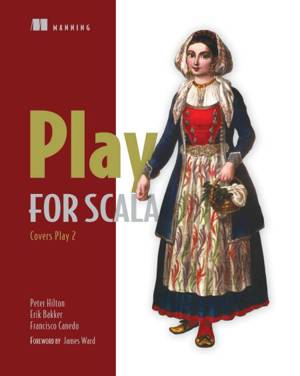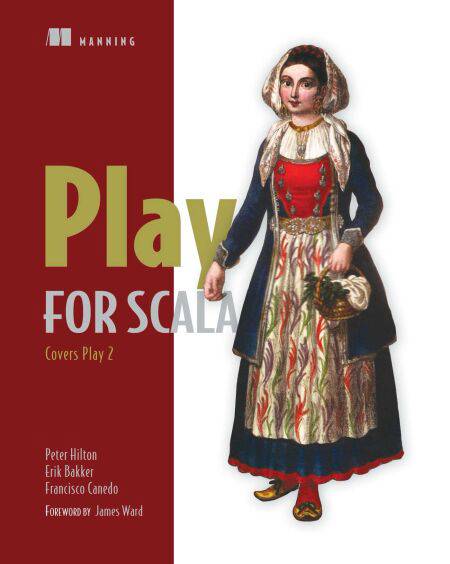
En raison d'une grêve chez bpost, votre commande pourrait être retardée. Vous avez besoin d’un livre rapidement ? Nos magasins vous accueillent à bras ouverts !
- Retrait gratuit dans votre magasin Club
- 7.000.000 titres dans notre catalogue
- Payer en toute sécurité
- Toujours un magasin près de chez vous
En raison de la grêve chez bpost, votre commande pourrait être retardée. Vous avez besoin d’un livre rapidement ? Nos magasins vous accueillent à bras ouverts !
- Retrait gratuit dans votre magasin Club
- 7.000.0000 titres dans notre catalogue
- Payer en toute sécurité
- Toujours un magasin près de chez vous
43,61 €
+ 43 points
Format
Description
Summary
Play for Scala shows you how to build Scala-based web applications using the Play 2 framework. This book starts by introducing Play through a comprehensive overview example. Then, you'll look at each facet of a typical Play application both by exploring simple code snippets and by adding to a larger running example. Along the way, you'll deepen your knowledge of Scala as a programming language and work with tools like Akka.
About this Book
Play is a Scala web framework with built-in advantages: Scala's strong type system helps deliver bug-free code, and the Akka framework helps achieve hassle-free concurrency and peak performance. Play builds on the web's stateless nature for excellent scalability, and because it is event-based and nonblocking, you'll find it to be great for near real-time applications.
Play for Scala teaches you to build Scala-based web applications using Play 2. It gets you going with a comprehensive overview example. It then explores each facet of a typical Play application by walking through sample code snippets and adding features to a running example. Along the way, you'll deepen your knowledge of Scala and learn to work with tools like Akka.
Written for readers familiar with Scala and web-based application architectures. No knowledge of Play is assumed.
Purchase of the print book includes a free eBook in PDF, Kindle, and ePub formats from Manning Publications.
What's Inside
Intro to Play 2 Play's MVC structure Mastering Scala templates and forms Persisting data and using web services Using Play's advanced features
About the Authors
Peter Hiltonv, Erik Bakker, and Francisco Canedo, are engineers at Lunatech, a consultancy with Scala and Play expertise. They are contributors to the Play framework.
Table of Contents
PART 1: GETTING STARTED Introduction to Play Your first Play application PART 2: CORE FUNCTIONALITY Deconstructing Play application architecture Defining the application's HTTP interface Storing data—the persistence layer Building a user interface with view templates Validating and processing input with the forms API PART 3: ADVANCED CONCEPTS Building a single-page JavaScript application with JSON Play and more Web services, iteratees, and WebSockets
Play for Scala shows you how to build Scala-based web applications using the Play 2 framework. This book starts by introducing Play through a comprehensive overview example. Then, you'll look at each facet of a typical Play application both by exploring simple code snippets and by adding to a larger running example. Along the way, you'll deepen your knowledge of Scala as a programming language and work with tools like Akka.
About this Book
Play is a Scala web framework with built-in advantages: Scala's strong type system helps deliver bug-free code, and the Akka framework helps achieve hassle-free concurrency and peak performance. Play builds on the web's stateless nature for excellent scalability, and because it is event-based and nonblocking, you'll find it to be great for near real-time applications.
Play for Scala teaches you to build Scala-based web applications using Play 2. It gets you going with a comprehensive overview example. It then explores each facet of a typical Play application by walking through sample code snippets and adding features to a running example. Along the way, you'll deepen your knowledge of Scala and learn to work with tools like Akka.
Written for readers familiar with Scala and web-based application architectures. No knowledge of Play is assumed.
Purchase of the print book includes a free eBook in PDF, Kindle, and ePub formats from Manning Publications.
What's Inside
Intro to Play 2 Play's MVC structure Mastering Scala templates and forms Persisting data and using web services Using Play's advanced features
About the Authors
Peter Hiltonv, Erik Bakker, and Francisco Canedo, are engineers at Lunatech, a consultancy with Scala and Play expertise. They are contributors to the Play framework.
Table of Contents
PART 1: GETTING STARTED Introduction to Play Your first Play application PART 2: CORE FUNCTIONALITY Deconstructing Play application architecture Defining the application's HTTP interface Storing data—the persistence layer Building a user interface with view templates Validating and processing input with the forms API PART 3: ADVANCED CONCEPTS Building a single-page JavaScript application with JSON Play and more Web services, iteratees, and WebSockets
Spécifications
Parties prenantes
- Auteur(s) :
- Editeur:
Contenu
- Nombre de pages :
- 328
- Langue:
- Anglais
Caractéristiques
- EAN:
- 9781638353713
- Date de parution :
- 02-10-13
- Format:
- Ebook
- Protection digitale:
- Adobe DRM
- Format numérique:
- ePub

Les avis
Nous publions uniquement les avis qui respectent les conditions requises. Consultez nos conditions pour les avis.






